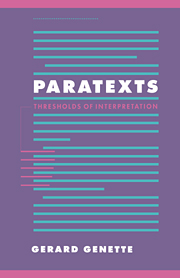Book contents
- Frontmatter
- Contents
- Foreword
- List of books by Gérard Genette
- Translator's note
- 1 Introduction
- 2 The publisher's peritext
- 3 The name of the author
- 4 Titles
- 5 The please-insert
- 6 Dedications and inscriptions
- 7 Epigraphs
- 8 The prefatorial situation of communication
- 9 The functions of the original preface
- 10 Other prefaces, other functions
- 11 Intertitles
- 12 Notes
- 13 The public epitext
- 14 The private epitext
- 15 Conclusion
- Additional references
- Index
13 - The public epitext
Published online by Cambridge University Press: 04 November 2009
- Frontmatter
- Contents
- Foreword
- List of books by Gérard Genette
- Translator's note
- 1 Introduction
- 2 The publisher's peritext
- 3 The name of the author
- 4 Titles
- 5 The please-insert
- 6 Dedications and inscriptions
- 7 Epigraphs
- 8 The prefatorial situation of communication
- 9 The functions of the original preface
- 10 Other prefaces, other functions
- 11 Intertitles
- 12 Notes
- 13 The public epitext
- 14 The private epitext
- 15 Conclusion
- Additional references
- Index
Summary
Definitions
The criterion distinguishing the epitext from the peritext – that is (according to our conventions), distinguishing the epitext from all the rest of the paratext – is in theory purely spatial. The epitext is any paratextual element not materially appended to the text within the same volume but circulating, as it were, freely, in a virtually limitless physical and social space. The location of the epitext is therefore anywhere outside the book – but of course nothing precludes its later admission to the peritext. Such admission is always possible, and we will encounter many examples of it: see the original interviews appended to posthumous scholarly editions, or the innumerable excerpts from correspondence or diaries quoted in the critical notes of such scholarly editions. This purely spatial definition, however, has some pragmatic and functional repercussions. When an author, such as Proust for Du côté de chez Swann, chooses to present his work (here, the beginning of his work) by way of an interview rather than a preface, he no doubt has a reason for making such a choice, and in any case his choice leads to these kinds of effects: reaching a broader public than the public of first readers, but also sending this public a message that is constitutively more ephemeral, destined to disappear when its monitory function is fulfilled, whereas a preface would stay attached to the text at least until deleted upon publication of a second edition, if any.
- Type
- Chapter
- Information
- ParatextsThresholds of Interpretation, pp. 344 - 370Publisher: Cambridge University PressPrint publication year: 1997



